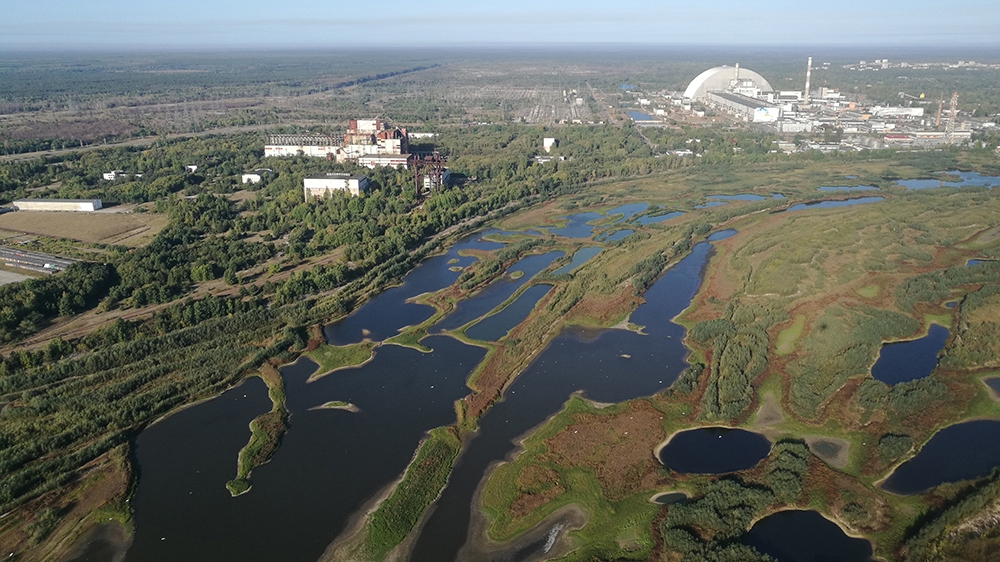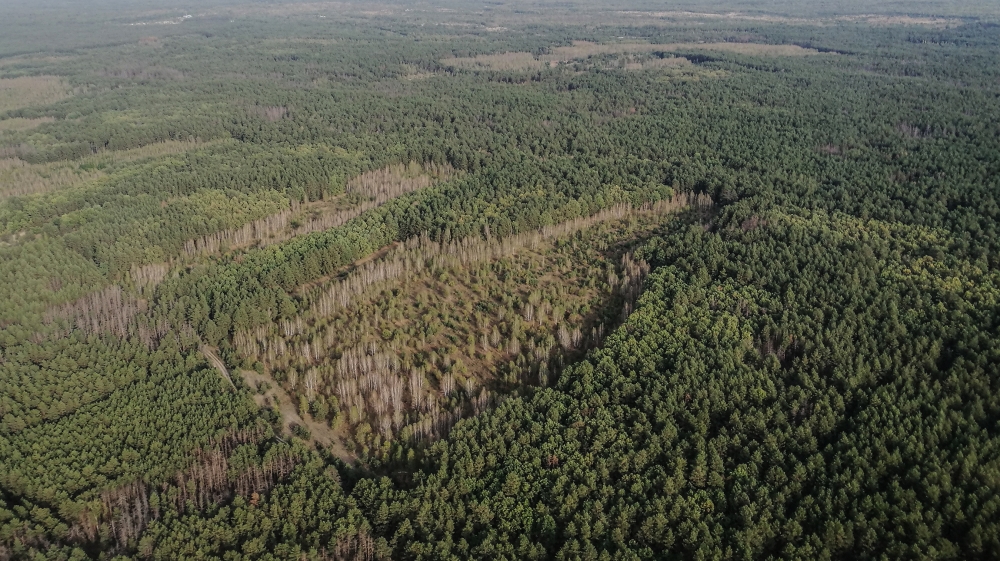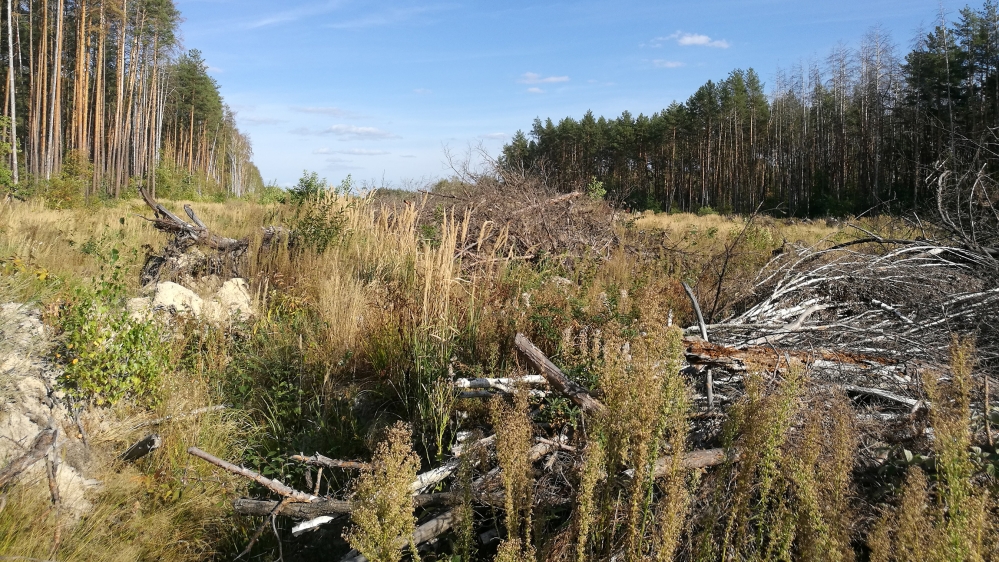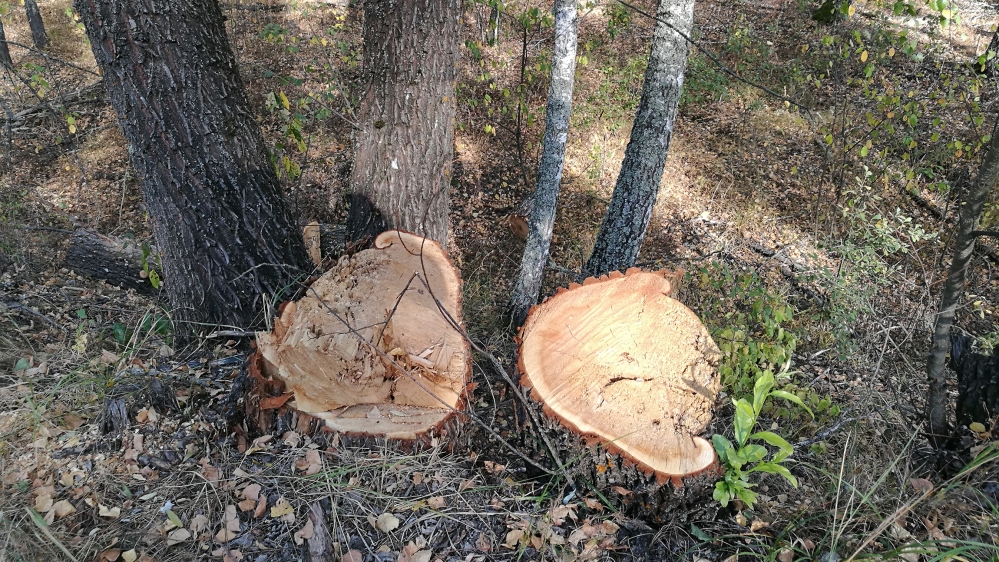In Chernobyl’s radioactive forest, arson and timber smuggling
More than 30 years after nuclear accident, fires pose environmental risks and stir fears over illegal logging.

Chernobyl, Ukraine – The site of the world’s worst nuclear disaster is not a barren, lifeless wasteland.
A dense, primordial forest dominates the “Alienation Zone” around the shutdown Chernobyl nuclear power plant where Reactor Four exploded in 1986.
Keep reading
list of 4 itemsAre seed-sowing drones the answer to global deforestation?
Rainfall set to help crews battling wildfire near Canada’s Fort McMurray
The Alabama town living and dying in the shadow of chemical plants
More than 100,000 people were evacuated from the city of Chernobyl and the nearby company town of Pripyat, and some 2,600sq kilometres (about 1,004sq miles) were cordoned off and fenced with barbed wire.
Trees and time erase the traces of humans here as pines, birches, oaks and poplars pierce through asphalt, sprout inside crumbling buildings and reclaim forlorn farmland.
Shrouding two-thirds of the Zone, the forest insulates radioactive contamination as vegetation and soil absorb particles of uranium-238, caesium-137 and other radionuclides that were rocketed out of Reactor Four.
Some of them will disappear within decades, but others render the Zone’s central part unfit for human habitation for tens of thousands of years. In outer parts of the Zone, heavily irradiated spots dot relatively uncontaminated areas.
But people never vacated the Zone.

Tourists throng several painstakingly decontaminated locations daily, often interacting with a handful of mostly elderly locals who refused to leave their otherwise abandoned villages and log houses.
Hundreds of workers monitor the shutdown plant and maintain the protective “sarcophagus” erected over Reactor Four. Police officers guard the Zone’s perimeter, inspecting vehicles and making sure each visitor gets screened for radiation.
What is more worrisome, humans do not leave the Zone’s forest alone.
If seen from a helicopter or satellite, its green mass is crisscrossed with long straight lines of clearings and peppered with bald spots and light-green patches of saplings and underbrush.
The “sanitary” clearings are the firebreaks carved out by Pivnichna Pushcha (Northern Forest), a state-run forestry whose sole purpose is to prevent fires in the Zone. If seen from the ground, the clearings look like gigantic amputations – football-field wide and tens of kilometres long, with trees reduced to pitiful stumps and soil eroded by snow and rainfall.
The fires that turn radionuclides into inhalable, windblown aerosols were especially devastating in recent years, sometimes lasting for weeks – and posing health risks to the people around the Zone, including the residents of Kyiv, Ukraine’s capital, that lies less than 100km (62 miles) to the south.
“The ash [the fires] generated can be extremely radioactive because all of the radionuclides that were contained in the trees are condensed and concentrated into the ash,” Timothy Mousseau, professor of biological sciences at the University of South Carolina, told Al Jazeera.
“Some of this ash can be dispersed great distances by wind to areas outside of the zone and thus affect people, while some of the ash settles near the site of the fire and can return the area to a very high level of radioactivity,” added Mousseau, who extensively studied the Zone’s forest.
But the light-green patches seen from above do not seem to be shaped by fires – they looktoo angular and geometric.

They reveal massive, perennial logging of trees, mostly tall, decades-old pines, oaks and ash-trees that often stand on contaminated soil – and fetch a good price at Ukraine’s timber market, according to corruption monitors and officials.
The forestry allegedly starts the fires to justify more logging of trees that are smuggled out of the Zone and sold through corruption schemes that yield tens of millions of dollars a year in profits, an anti-corruption group claims.
“These fires were artificial so that the fire-damaged forest could be felled without a problem, and taken away as timber,” Roman Bochkala, head of Stop Corruption, a non-profit in the Ukrainian capital, Kyiv, that investigates graft in the Zone, told Al Jazeera.
Some Ukrainian officials agree with him.
“I have no doubts why fires near Chernobyl emerge – they are an attempt to hide illegal logging,” Mykola Tomenko, head of the parliamentary commission on the environment, told reporters in May 2015, during one of the longest and fiercest fires that burned hundreds of hectares of the Zone’s forest.
Ihor Shevchenko, the environment and natural resources minister at the time, also claimed that the fire was set by “the people involved in illegal felling”.
Pivnichna Pushcha’s head forester, Serhiy Khalash, refused to be interviewed for this story and referred this reporter to his parent organisation, the state-run Agency for the Management of the Exclusion Zone. The agency did not respond to requests for an interview.

Last year, at least three large fires were reported in the Zone, including one in the Red Forest, one of the most irradiated areas where most of the trees died and turned red in 1986.
The agency is allowed to sell limited amounts of the Zone’s timber since 2004 as long as each tree is scanned for radioactivity. The trees that failed the scan are used to fuel a power station that has filters to prevent the release of contaminated ash, the forestry reportedly said.
But Stop Corruption claims that the timber they tracked left the Zone without scanning and documentation. It alleges to have tracked the timber to furniture factories, and claims some of it was shipped to Romania and can further be resold in the European Union.
“This gray and often illegal business goes on under a semi-legal cover. There is an official forestry service, there are state companies, there are supervisors, but because everyone has a finger in the pie, everyone turns a blind eye,” Bochkala claimed.
Experts, however, soft-pedal the health risks of Chernobyl furniture.
“Ninety percent of wood can be safely used to manufacture furniture,” Dmytro Golyak of the Ukrainian Institute of Agricultural Radiology told Al Jazeera. He decried, however, a lack of thorough research into the long-term effects of irradiated wood on human health.
“I believe most of the logging is being done along the periphery of the zone and thus in areas where the trees are not especially radioactive. Hence the hazard posed by furniture is not likely to be huge,” Professor Mousseau said.
He is more worried about another use of Chernobyl timber.

In 2007, state inspectors found charcoal with radiation levels exceeding the permissible levels four times that was sold in some Ukrainian supermarkets.
Police raided two charcoal workshops, but no culprits – who could have faced between five and 10 years in jail for “illegal handling of radioactive materials”, have been detained.
“The use of radioactive charcoal is inherently more hazardous than furniture as the health risks stemming from the ingestion of radioactive materials can be significant,” Mousseau said.
Zone’s timber brings tens of millions of dollars in illicit profits a year, amounting to two-thirds of Chernobyl’s illicit profits that stem from the smuggling of scrap metal, berries, mushrooms and fish, Bochkala concludes.
“This is what feeds all the [corrupt] freeloaders who cling to the zone like leeches and live off it,” he said.